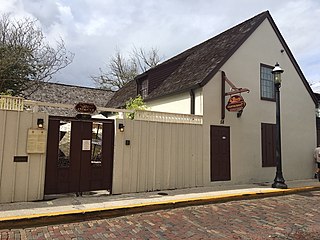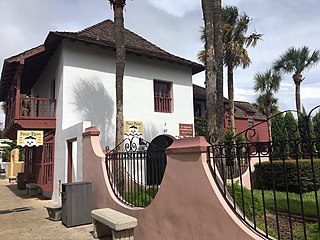
The Memorial Presbyterian Church is a historic church constructed in St. Augustine, Florida, in 1889 by American industrialist Henry Morrison Flagler. It is located at 32 Sevilla Street. It was dedicated to the memory of his daughter Jennie Louise Benedict, who died following complications from childbirth at sea in March 1889.

The Ribera House is located at 22 St. George Street in St. Augustine, Florida. It is a reconstruction of the home that originally stood on this site during the First Spanish Period (1565-1764) of St. Augustine.

The Triay House is a historic property located at 31 St. George Street in St. Augustine, Florida. It is a reconstruction of the First Spanish Period structure that stood on the site.

The Sánchez de Ortigosa House is located at 60 St. George Street, St. Augustine, Florida. It is a reconstruction of a home dating from the First Spanish Period (1565-1763) that stood on this site.

The Arrivas House is located at 46 St. George Street, St. Augustine, Florida. It was the first completed restoration project of the Historic St. Augustine Preservation Board (HSAPB), and was named after early owner Don Raimundo de Arrivas.

The Cerveau House is located at 26 Cuna Street in St. Augustine, Florida. It is an original house, constructed in the 19th century.

The Florida Heritage House is located at 1 Aviles Street, or 11 King Street, in St. Augustine, Florida. It is a reconstruction of a late Spanish colonial-style house built in the 19th century.

The Gómez House, located at 27 St. George Street in St. Augustine, Florida, is a reconstruction of a simple wooden house dating back to Florida’s First Spanish Period (1565-1763).

The De Mesa-Sánchez House is located at 23 St. George Street in St. Augustine, Florida. It is a restoration of a home dating back to East Florida's First Spanish Period.

The Luciano de Herrera House is located at 58 Charlotte Street in St. Augustine, Florida. It is a reconstruction, depicting a house from St. Augustine's Second Spanish Period (1784–1821).

The Ortega House is located at 70 St. George Street in St. Augustine, Florida. It is a reconstructed home representing the architectural style of the First Spanish Period (1565-1763) in Florida.

The Marin-Hassett House is located at 97 St. George Street in St. Augustine, Florida. It is reconstructed on its foundations that date to St. Augustine's First Spanish Period.

The Joaneda House is located at 57 Treasury Street in St. Augustine, Florida. It was restored to be an example of a Second Spanish Period (1784-1821) residence. It is one of the oldest buildings in Florida.

The Salcedo House and Kitchen are located at 42 and 42 1/2 St. George Street, in St. Augustine, Florida. They are reconstructions of 18th century structures that stood on these sites in St. Augustine's First Spanish Period (1565–1763).

The Pellicer-De Burgo House is located at 53 St. George Street in St. Augustine, Florida. It is a reconstruction of two connected houses built during the British Period (1763-1783) of East Florida.
Earle W. Newton, II (1917–2006) was a historian, preservationist, publisher, educator, and art benefactor.

The Hispanic Plaza is a garden in St. Augustine, Florida owned and maintained by the St. Augustine Foundation, Inc. It is closed to the public and is only opened for special city events.

Elizabeth Towers (1899–1985) was an American philanthropist and socialite known for her dedication to historic preservation in northeast Florida.

The Paredes-Dodge House is located at 54 St. George Street in St. Augustine, Florida. The one and a half story structure was built between 1803 and 1813, and is one of the only surviving colonial structures in St. Augustine.

The Segui-Kirby Smith House is a historic house at 12 Aviles Street in St. Augustine, Florida. Built in the late 1770s, it was the childhood home of Confederate States Army General Edmund Kirby Smith (1824–1893), the commanding general of the Trans-Mississippi Department from 1863 to 1865 and the chancellor of the University of Nashville from 1870 to 1875. It is owned and operated by the St. Augustine Historical Society and is home to the St. Augustine Historical Society Research Library.



















